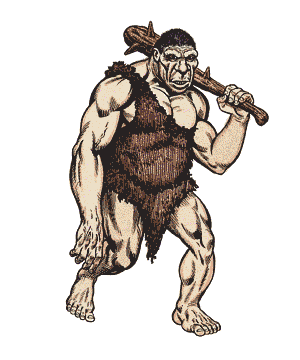| Climate/Terrain: | Any hills and mountains |

|
| Frequency: | Rare | |
| Organization: | Tribal | |
| Activity Cycle: | Any | |
| Diet: | Omnivorous | |
| Intelligence: | Low (5-7) | |
| Treasure: | D | |
| Alignment: | Chaotic evil | |
| No. Appearing: | 1-12 | |
| Armor Class: | 3 (5) | |
| Movement: | 12 | |
| Hit Dice: | 12+1-2 hit points | |
| THAC0: | 9 | |
| No. of Attacks: | 1 | |
| Damage/Attack: | 1-6 or by weapon (2-12+7) | |
| Special Attacks: | Hurling rocks for 2-16 (2d8) | |
| Special Defenses: | Nil | |
| Magic Resistance: | Nil | |
| Size: | H (16' tall) | |
| Morale: | Elite (13-14) | |
| XP Value: | 3,000 | |
| Infant | Nil | |
| Juvenile, -3 | 270 | |
| Juvenile, -2 | 650 | |
| Juvenile, -1 | 2,000 |
Hill giants are selfish, cunning brutes who survive through hunting and by terrorizing and raiding nearby communities. Despite their low intelligence, they are capable fighters.
Hill giants are oddly simian and barbaric in appearance, with overly long arms, stooped shoulders, and low foreheads. Even though they are the smallest of the giants, their limbs are more muscular and massive than those of the other giant races. The average hill giant is 16 feet tall and weighs about 4,500 pounds. Females have the same builds as males. Their skin color ranges from a light tan to a deep ruddy brown. Their hair is brown or black, and their eyes are black. Hill giants can live to be 200 years old.
Hill giants' natural Armor Class is 5. This is reduced to an Armor Class of 3 when they wear crudely-sewn animal hides, which are the equivalent of leather armor. Nearly all hill giants wear these hides, which are a symbol of esteem in some hill giant communities -- the more hides a giant has, the more large kills to his credit. Only a few (5%) of the giants fashion metal armor from the armor of men they have defeated. These giants have an Armor Class of 0. Like other races of giants, hill giants carry their belongings with them in huge hide sacks. A typical hill giant's bag will contain 2-8 (2d4) throwing rocks, the giant's wealth, and 1-8 additional common items.
Hill giants speak their own language and a tongue common to all giants. In addition, 50% also speak ogre.
Combat: Hill giants prefer to fight their opponents from high rocky outcroppings where they can pelt their targets with rocks and boulders while limiting the risks posed to themselves.
Hill giants' favorite weapons are oversized clubs which do 2-12 +7 points of damage (double the damage of a man-sized club plus their strength bonus). They hurl rocks for 2-16 (2d8) points of damage. Their targets for such attacks must be between 3 and 200 yards away from the giant. They can catch rocks or other similar missiles 30% of the time.
Habitat/Society: A hill giant lair will have 9-16 (1d8+8) giants; usually an extended family. Sometimes these families will accept lone hill giants into their folds. If six or more giants are encountered in a lair, half of them will be male, one quarter will be female, and the remainder will be immature giants. To determine a giant's maturity, roll 1d4. A roll of 4 indicates an infant with no combat ability and hit points of gnoll; rolls of 1-3 indicate older progeny with hit dice, damage, and attack rolls equal to that of an ogre.
Occasionally a hill giant with an average intelligence can be found. Such a giant is capable of rallying bands of his peers so 2, 3, or 4 times the number of giants usually appearing can be encountered. These "giant kings," as they call themselves, stage raids on human towns or against other races of giants.
Although hill giants prefer temperate areas, they can be found in practically any climate where there is an abundance of hills and mountains. They lair in caves, excavated dens, or crude huts. Those who live in colder climates have developed more skills with preparing and using skins to keep themselves warm and to keep the harsh winds out of their lairs.
There is a 50% chance a band of hill giants will have guards in their lairs, and the guarding creatures will be 2-8 (2d4) dire wolves(50%), 1-3 giant lizards> (30%), or a group of 2-8 (2d4) ogres (20%).
The majority of hill giants are suspicious of magic and will seek to destroy magic items they acquire as treasure. They ceremonially kill mages.
Ecology: Hill giants' main diet consists of meat, which they obtain by hunting. The flesh of young green dragons is considered a delicacy, and frequently giants who live on hills and mountains covered with forests will organize hunting parties in search of green dragon lairs. In turn, green dragons have been known to hunt hill giants.
Sometimes bands of hill giants will trade with each other or with bands of ogres to get foodstuffs and trinkets.
| Previous Index Next | Cover Up |
Сайт создан в системе uCoz